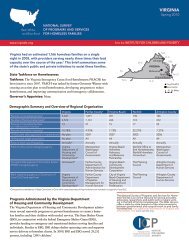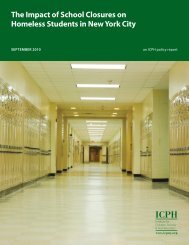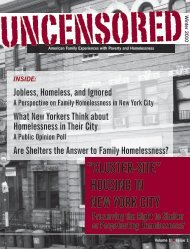UNCENSORED, American Family Experiences with Poverty and ...
UNCENSORED, American Family Experiences with Poverty and ...
UNCENSORED, American Family Experiences with Poverty and ...
- No tags were found...
You also want an ePaper? Increase the reach of your titles
YUMPU automatically turns print PDFs into web optimized ePapers that Google loves.
<strong>UNCENSORED</strong>The Historical PerspectiveCharles Loring Brace <strong>and</strong> the Children’s Aid Societyby Ethan G. SribnickIn the middle of the nineteenth century, New York Cityfaced its first epidemic of child poverty <strong>and</strong> homelessness.This crisis <strong>and</strong> the reaction to it had long-lastingeffects; it popularized the word “homeless” <strong>and</strong> led to thebeginnings of modern family foster care.children who lacked a nurturing home, reformers adoptedthe word “homeless.” By their definition, homeless childrenincluded those <strong>with</strong>out shelter or family support, butalso those children who had a place to live but spent theirdays working on the streets.In 1849, George W. Matsell, the city’s chief of police,warned of the increasing number of child vagrants on thestreets of New York. Boys, according to Matsell, loitered atthe piers, stealing recently unloaded dry goods. Girls actedas crossing sweepers, dem<strong>and</strong>ing tips for sweeping themud out of pedestrians’ paths, <strong>and</strong> peddled small itemslike “fruit, socks, [<strong>and</strong>] toothpicks.” Some of these childrenlived on the street, sleeping in boxes or “occasionally incheap lodgings,” havingno homes or families toreturn to at night.Many of these childrenwere the offspring ofimmigrants, mostly fromIrel<strong>and</strong> <strong>and</strong> Germany,who flooded into NewYork in the 1840s <strong>and</strong>1850s. These parents,struggling to survive inthe city, sent children outto work or worked suchlong hours themselvesthat their children wentunsupervised. At thesame time, a new generationof middle-classreformers believed allchildren, even the poorchildren of immigrants,should be sheltered ina loving home free ofthe burden of work. Todescribe the city’s poorCharles Loring Brace ultimately developed the mostinnovative <strong>and</strong> influential response to this midcenturyepidemic of childhood homelessness. Born in 1826,Brace found his calling in the ministry. While completingseminary in New York City, Brace ministered to the city’spublic poorhouse. This experience transformed him; by1850, he looked to apply his theological training to socialproblems. Accordingly, Brace founded the Children’s AidSociety (CAS) in 1853,dedicated to the “generalimprovement of the conditionsof the homeless<strong>and</strong> friendless childrenroaming the streetsof New York.” Unlikeother reformers of hisera, Brace asserted thatmassive institutions likeorphanages or juvenileasylums could not rearhealthy, virtuous children.Instead, he argued,asylums often led to “ahidden growth of secret<strong>and</strong> contagious vices.”Charles Loring Brace founded the Children’s Aid Society in 1853. His innovativeapproach to helping homeless children provided an alternative to institutions<strong>and</strong> created the beginnings of modern family foster care.Rather than warehousingchildren in asylums,Brace <strong>and</strong> CAS developeda two-track strategyto alleviate childhoodhomelessness. On onetrack they openedschools, lodgingpage 26










